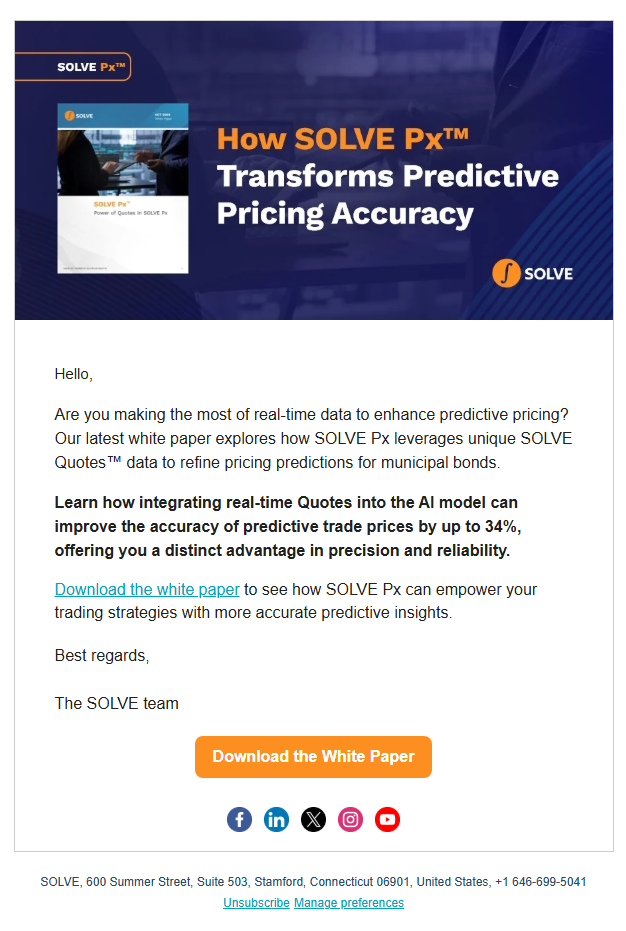NEWSROOM
If you have varying evaluated prices for a security, how do you choose which evaluate firm pricing it best? If you have varying dealer quotes that are far apart, how do you determine which is best?
RAJAN CHIARI: Yeah, I mean obviously it’s judgmental—100 percent but it’s usually going back to the same principles, doing some sort of study, you know, looking at the evaluated prices compared against the transactional data that might be available, particularly starting with your own trades, talking with your own trading group on what they’re seeing, and hearing and then trying to evaluate whether or not one of the sources is better. The same sort of argument one might have in deciding whether to use a bid price or mid-pricing because it’s the same sort of question: what are we actually trading at? So, I think that’s fundamental to helping make a determination of which source might be most appropriate for a particular security or asset class.
EUGENE GRINBERG: And to second that, this is exactly how our data is being used in the middle and back office because firms often source multiple prices from the evaluated pricing services, and when markets are calm, those are typically in line, but oftentimes they could be 5-10 points apart or more. This is exactly where market color and observable data is key—where you could go back to the value pricing service and potentially point out something that they haven’t seen or decide that, for this particular security, some peers potentially have access to data that other people are not seeing so we’re going to go with this level.
PIERCE LORD: Yeah, so part of it is what was mentioned earlier about the study. Having a rigorous process whereby you’re back testing the different sources to know which are more accurate. You can even do that at a sub asset class level. Just because XYZ firm is no good at this asset class, they could be fantastic at another asset class so doing those types of studies is the most obvious way of forming those opinions, and those studies are versus trades to see how close they are to our executions. And the other part of it is really understanding those sources, that is an important piece. It does come back to people as well—the evaluators in particular. In a fast market, if you show two bids and they’re both very different from where the price was from the evaluation then something has moved, and the question is how much it has moved. A good evaluator can very quickly assess by looking at other data points on other bonds in the market of the same issuer or other issuers that are comparable. They can very quickly assess: ‘wait, this one is an outlier—this is a bad data point because they overshot or it’s too low’. And again, you don’t want an evaluator to be looking at those situations all the time because they’ll be inundated with it. There is a lot of market data. And that’s again where it can be coupled with a technology solution that has dynamic outliers that can provide or ask the same question of the evaluator and expert. That is tough to decide from a technology-data standpoint alone. In other words, it’s “give me the answers that I really need” when a person gets involved to better understand what should be thrown out as an ally and what shouldn’t. So, it does come down to process, but you can use studies in statistics—you can also use the experts. I do believe a marriage of both those two things are what provide consistent good prices in fixed income.
EUGENE GRINBERG: Perfect, and to bolster that point, in the early part of the presentation when I spoke about the five pieces of the puzzle and the critical workflow tools. Some of the tools that are available in our product that go side by side with the data is exactly around what you just mentioned right, so it’s the ability to identify comparable securities, it’s looking up and down the capital structure when there may not be a whole lot of information available, you know, potentially identifying another security that’s paripassu, looking at other deals of the same issuer or other deals in the same industry, and so on. So, there is a good amount of screening and filtering that’s available when there’s not a lot of information that exists on the security that you care about.
Listen to the recording starting at minute 32:27 of the Valuations Webinar
To learn more, visit www.solveadvisors.com or contact us directly: info@solveadvisors.com or +1-646-699-5041.
 BDCs
BDCs  SOLVE Insights
SOLVE Insights  SOLVE Newsroom
SOLVE Newsroom 






